This is a German Chef Knife In Shape And Function, But Born And Bred On US Soil.
Lamson is a Massachusetts based company that’s been making knives and tools since around the mid 19th century. They’ve pulled in their focus over the centuries from frontier equipment to kitchen cutlery, and the kitchen knife world is the better for it.
Like a lot of western kitchen knife companies out there, Lamson tends to make their stuff for durability over out-of-the-box performance. That’s not to say the Premiere chef knife doesn’t perform well. In fact, it holds its own pretty well against knives made by better known companies in about the same price range. But it’s worth noting that if you like thin blades with a really hard bite, this isn’t the kind of knife for you.
It has an edge that can do a little bit of delicate work with lighter stuff like herbs and greens, but it’s a heavy work horse. This is a good knife for the ham fisted meat searing, bone cracking, garlic smashing cooks of the world.
Specifications
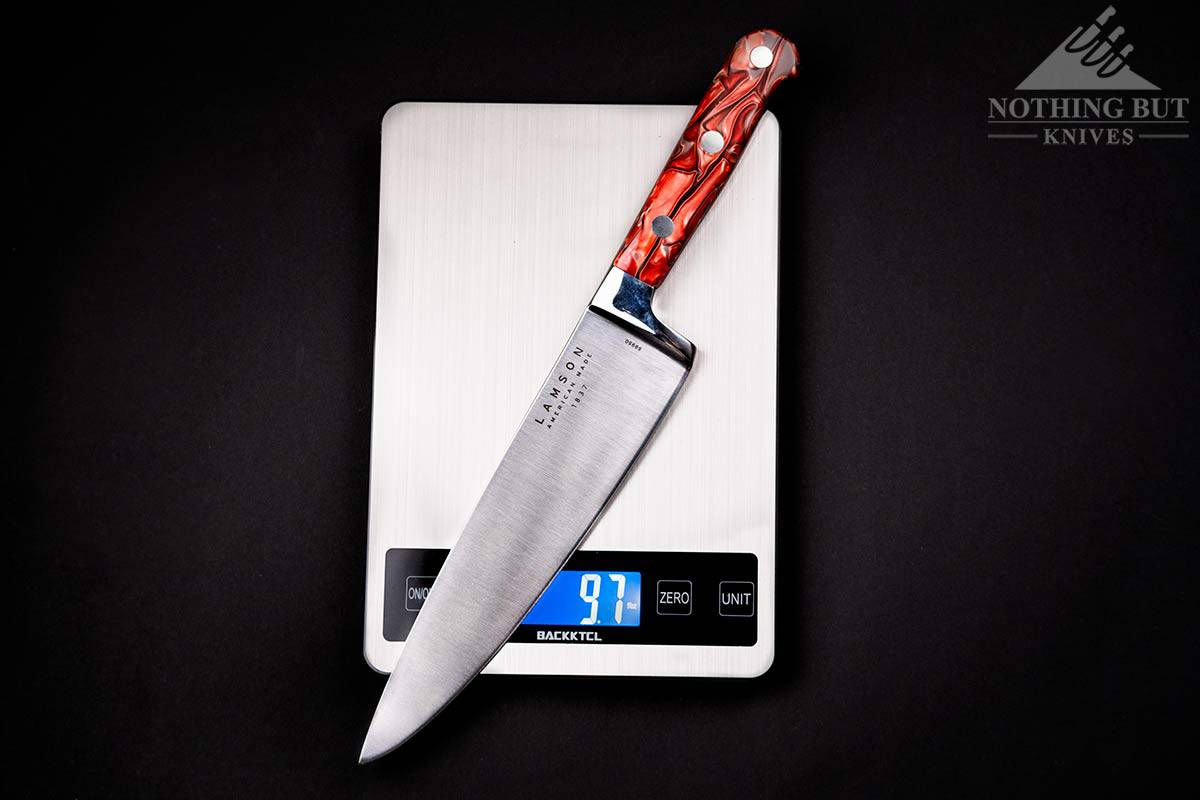
| Overall Length | 13″ |
| Blade Length | 8″ |
| Style | Western Chef |
| Handle Length | 5″ |
| Blade Steel | German 1.4116 |
| Blade Grind | Flat |
| Handle Material | Acrylic |
| HRC Rating | 58 |
| Weight | 9.7oz |
Pros
| Fills the hand well in full grip |
| Good balance |
| Strong edge and blade |
| Full tang |
CONS
| Could be a little sharper |
| Full bolster |
The Handle and Ergonomics
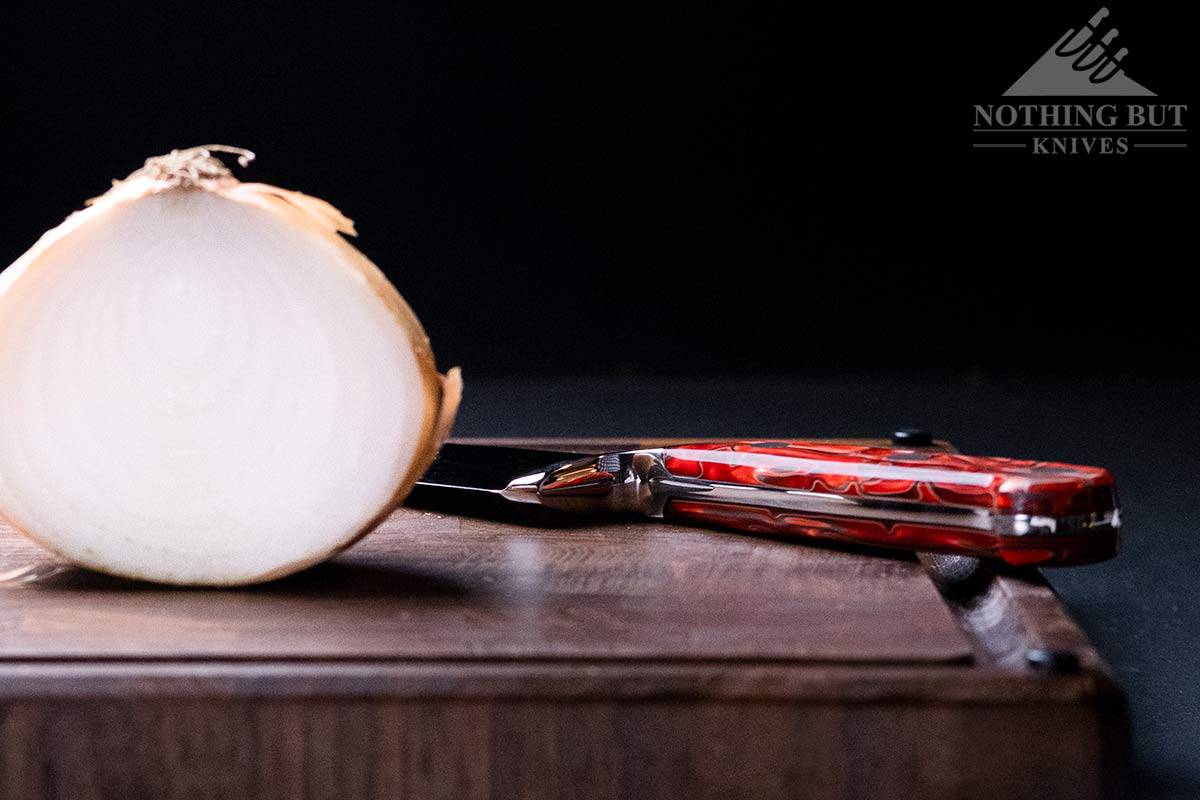
The size and shaping of the handle on this knife feel just about perfect for me. It’s wide and the corners have been completely rounded out so I can squeeze and push on the handle without it biting into my palm. Even though it’s made from a very smooth acrylic, it has plenty of surface area to stick to my hand and give my fingers room to find purchase in a pinch grip.
Even the weight feels good because they’ve gotten the balance point right around the bolster. I didn’t feel any strain in my hand from the weight under moderate use because this is pretty easy to hold and maneuver.
I’d say this has about an average weight where German style chef knives are concerned, though. It weighs about the same as a Wusthof Ikon, but it has the same balance as the Zwilling Professional S so the heft of the knife sits pretty comfortably within your palm in a pinch grip. It’s a pretty big difference from the handle-heavy feeling of the Ikon.
Also the Looks
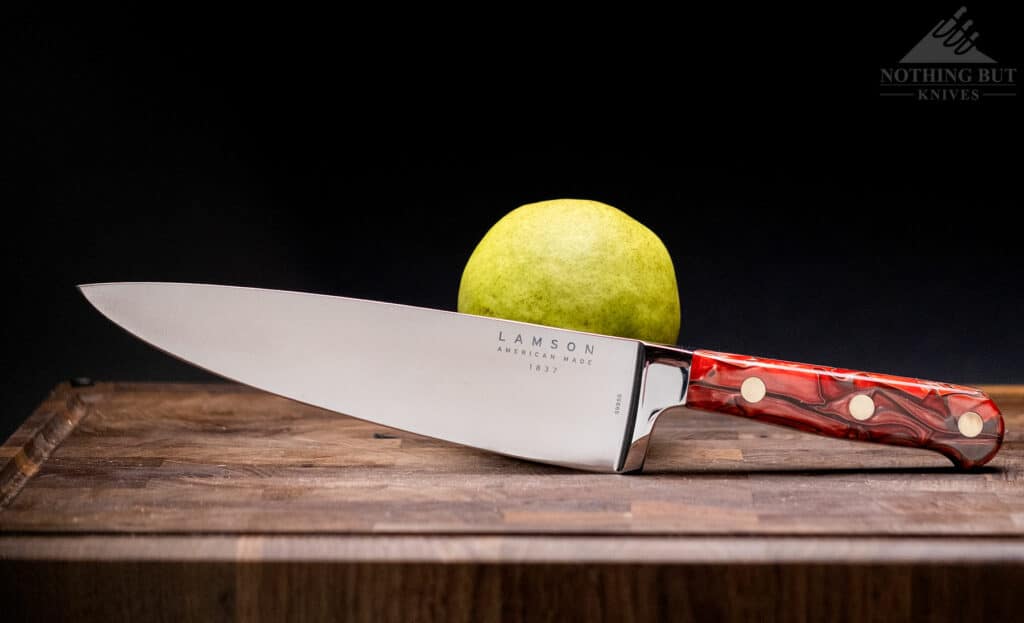
The clear stand out feature of this knife in particular is the color of the handle. Obviously it does nothing to help the performance of the knife, but the red acrylic isn’t something you see a lot in the kitchen knife world (or even in the EDC knife world).
Lamson does offer this in the classic black or a more rustic walnut handle. Both of those look nice, but they definitely don’t pop like the Fire Forged version.
While this makes it a pretty neat option if you have a particular color theme for your kitchen decoration (or if you just like the color red), it’s also a handy thing for people working professionally in a busy kitchen. That is a world fraught with accidental knife theft, because the majority of kitchen knives used in those places are standard western or Japanese style knives with black handles, so it’s easy to lose track of your favorite knife in someone else’s knife roll.
It would be pretty hard to mistake Lamson’s Premiere Fire series for the Victorinox Fibrox Pro, though. Unless, that is, someone else in the kitchen has a red-handled Swiss Classic, but even then the patterns and handle shapes are pretty distinct.
Also, what are the odds of two different cooks having knives with red handles in a professional kitchen? What the hell kind of place are you working at?
The Blade and Cutting Action
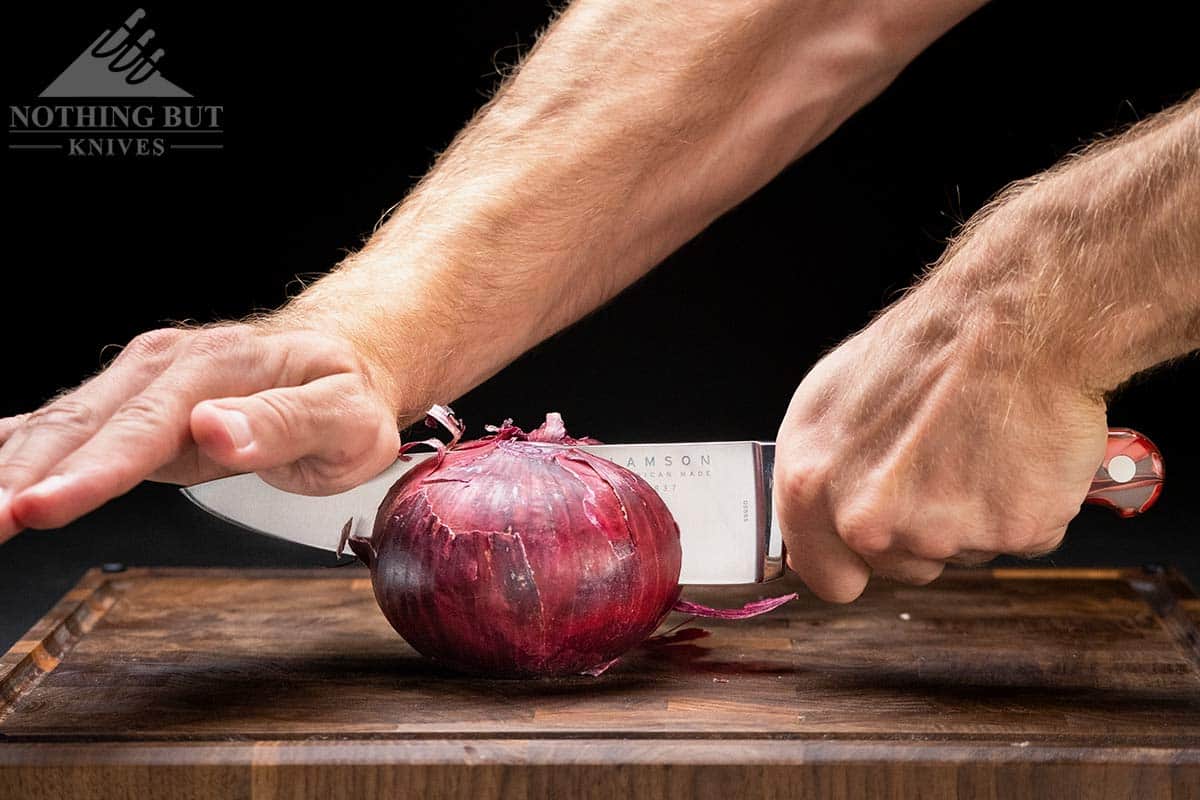
I’ve gone back and forth on whether I like the way the Lamson Premiere cuts. It is definitely sharp, but the primary grind is so short and the secondary grind almost feels like a convex coming off the bevel so it doesn’t have a very aggressive bite, but it feels incredibly smooth in the follow through once I’ve got it started.
have to run a bit of edge length before the edge sinks into most softer foods with a skin, and it’s as good at cutting super thin slices as other western-style knives in a similar price range (which is to say, not as good as a decent gyuto or santoku knife). But it just feels nice. The cuts feel so gentle with this knife that I don’t always realize when I’ve sliced all the way through something because the blade parts things so smoothly that I don’t feel or hear the sort of pop of getting through the skin of an onion, for example, against the cutting board.
Part of my issue with it comes from having spent so much time with Japanese kitchen knives, which are mostly meant to be used in short push cuts. The Lamson Premiere doesn’t have that kind of rapid fire action, though. You need to draw the edge a little to get past the skin of a tomato, but once you’re past that this knife feels great.
Foods It’s Good At: Meat and Herbs, but Less with Vegetables
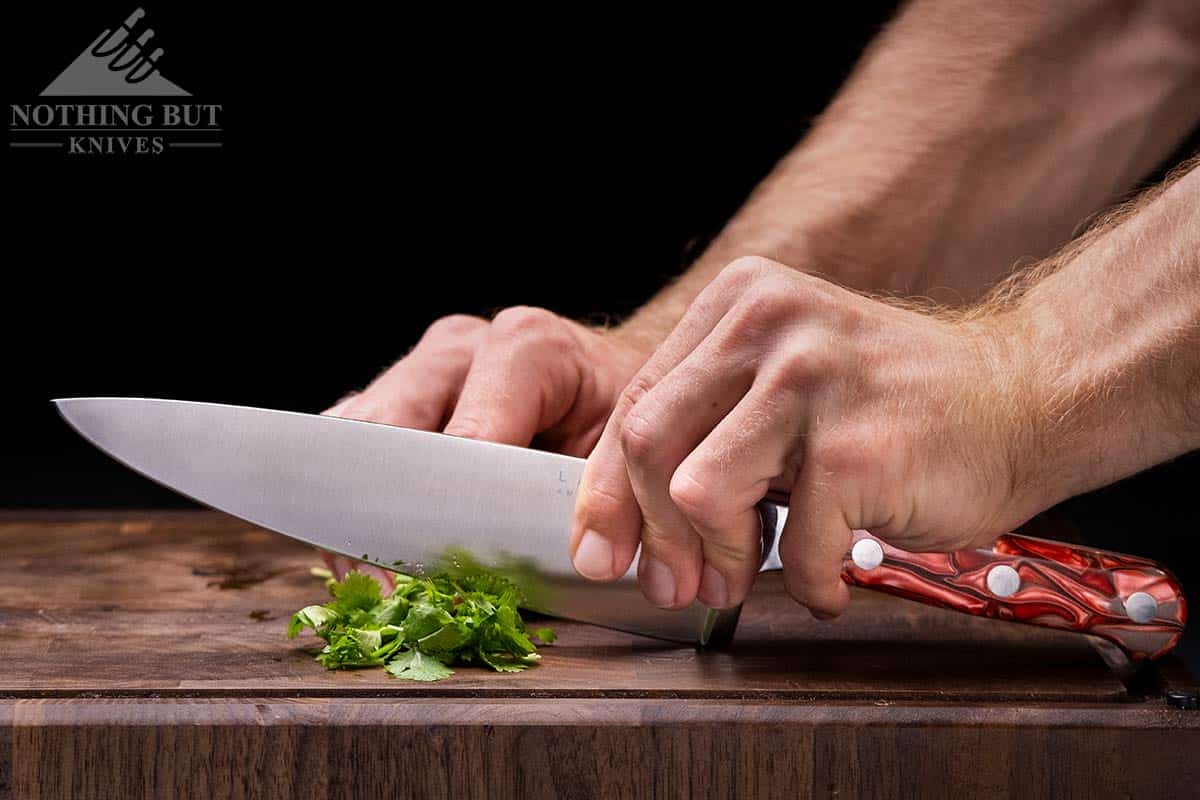
I had mediocre results with my standard salsa test. The Premier isn’t exactly optimized for cutting thin pieces of things, so if you’re making something like pico de gallo you’ll probably end up with your tomatoes, onions, and peppers on the chunkier side. And while it can cut through carrots, celery, and onion just fine, it’s not going to make it easy to do fancy or super fine cuts.
Full honesty, though, you could probably get finer diced cuts if you have a steadier hand than me, which isn’t hard to do.
Surprisingly, this can rock chop herbs like a champ. It made consistently clean cuts on a pile of cilantro, and I actually managed to get onion pieces down to a fine size after I failed to dice it to the size I wanted the first time around. So you could actually pull off a halfway decent chiffonade cut with this knife.
The edge also turned out to be pretty nice for both raw and cooked meat. Again, it’s not optimized for cutting super thin slices of anything, but it eases into food through a long cut in a way that feels really easy to control.
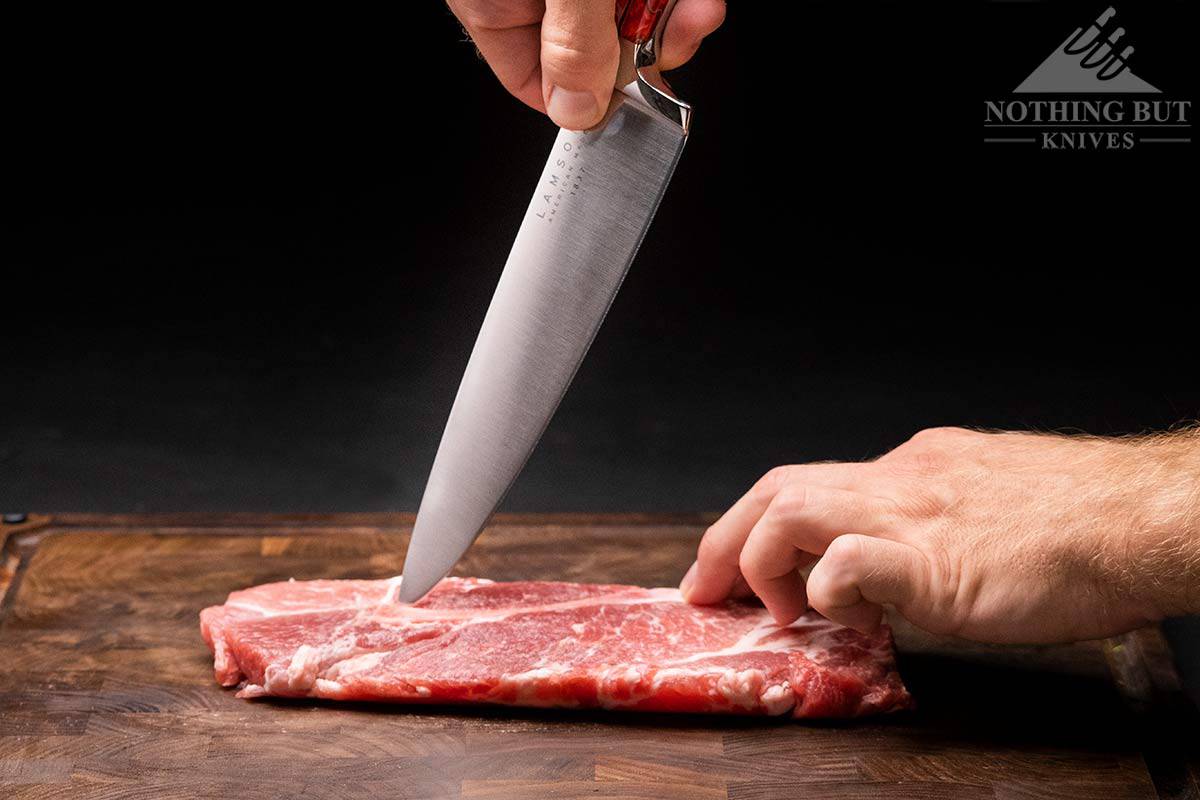
It’s pretty easy to separate meat off the bone and section that meat into manageable slices. Plus. the combination of the edge and the overall weight and thickness of this knife make it a really nice tool for working with whole chickens or pork shoulders. It’s only just sharp enough to cut tendons, but it’s plenty strong enough to separate joins and push through cartilage without me having to worry about causing much damage to the knife..
The Edge is too Thick, Though
For all my talk about the “smooth, pillowy” cutting of this knife, at some point I have to admit that it could probably stand to be sharper. The factory sharpness is getting plenty of work done for me, but there’s a little room for thinning the edge out just a little to make it easier to get through a tomato skin or start the dicing lines on an onion.
Granted, these aren’t exactly the kinds of things a western chef knife is meant to excel at, but they are things that other western chef knives are better at. It’s not exactly fair to compare Lamson to Wusthof considering the price difference, but I think the main thing preventing the Lamson Premier from cutting like the Wusthof Ikon is a little bit of time on a sharpening stone.
But the Full Bolster
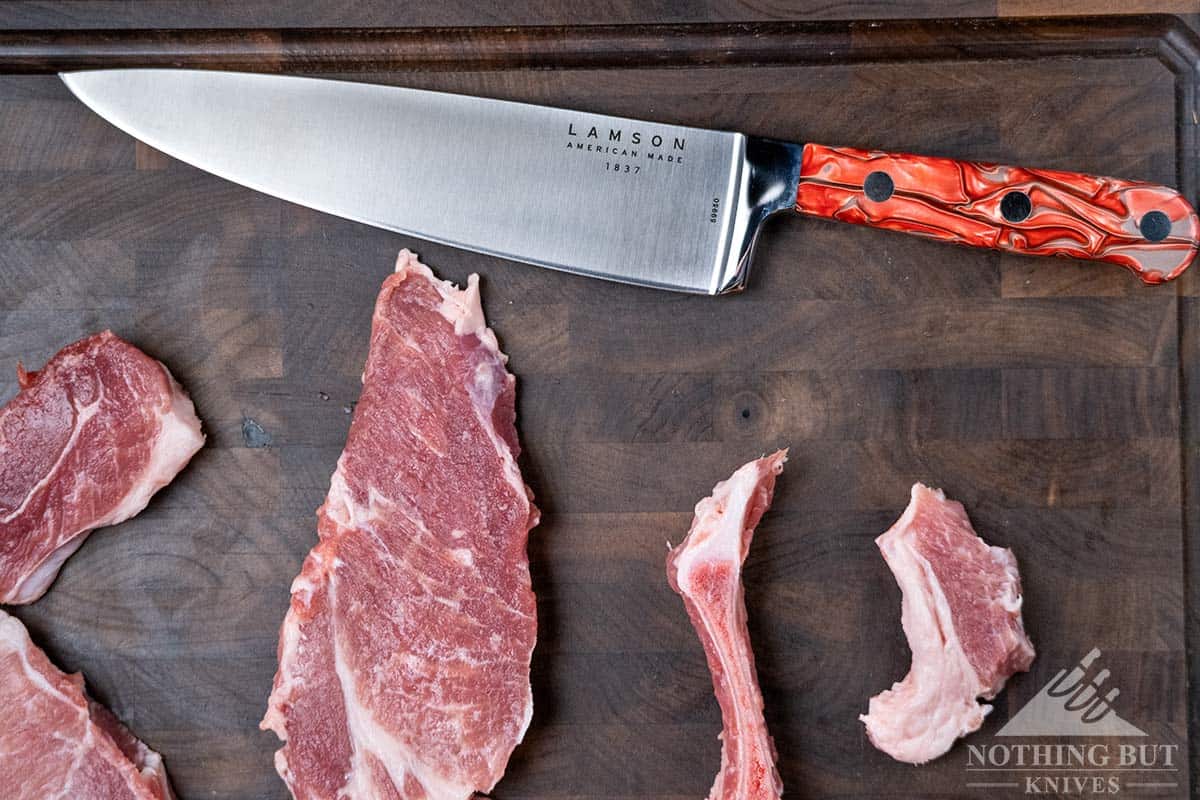
And there we run into the other issue of the full bolster, which will make it harder to get a full sharpened edge. I find myself complaining about full bolsters a lot with kitchen knives, but it’s a slightly bigger issue with the Lamson Premier because there doesn’t seem to be a half bolster version.
Normally this is the part where I would say “the full bolster sucks, but the knife is great so just get their half bolster version”. Unfortunately, the closest thing we have to that option with Lamson is their Vintage series. Those knives look cool and all, but nothing in that line up has the same feeling as the Premier Fire Forged chef knife.
Lamson’s Vintage knives are thinner, and have a different balance, so the ergonomics lean in the opposite direction from the Premiere Forged knives. That’s great for people who want the slimmed down feeling, but in a perfect world Lamson would make the Premiere Forged knives in full bolster and half bolster versions similar to how Zwilling makes their Pro and Pro S knives. Then finicky people like me could get a knife with a thick handle that’s still comfortable in a pinch grip.
Comparison and Alternatives
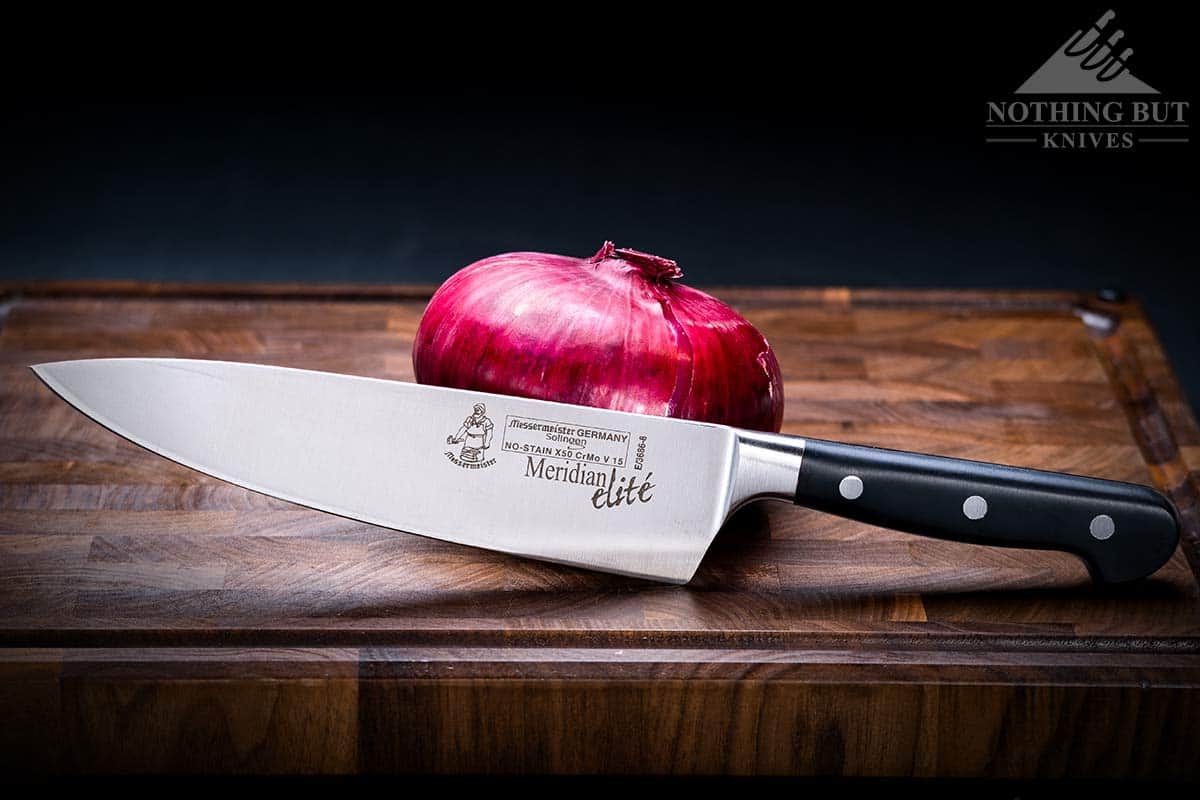
The Lamson Premiere chef knife generally shows up for around $120 which places it safely under the price point of the Zwilling Professional chef knife. I’d place both of these knives at about the same performance in terms of cutting, but I would recommend the Zwilling Pro if you want something a little lighter. It might also cut just a little better, but I definitely like the feel of the handle on the Lamson more.
The other similarly priced option is the Messermeister Meridian Elite chef knife. It’ll be a bit heavier, but the grind is thinner and it’s heavier toward the blade so it has a more aggressive bite. If you really need to clean cutting action, this might be a better option. But again, this knife averages at least $30 higher than the Lamson from most vendors.
Basically, what I’m saying here is that there might be other knives in the same style that are a bit better, but none of them seem to quite match the Lamson Premier’s ratio of cost to performance.
If you like the style of the Lamson, but want something that is German, check out our article on our Favorite German Chef Knives, here.
Final Thoughts on One of The Few American Made Chef Knives
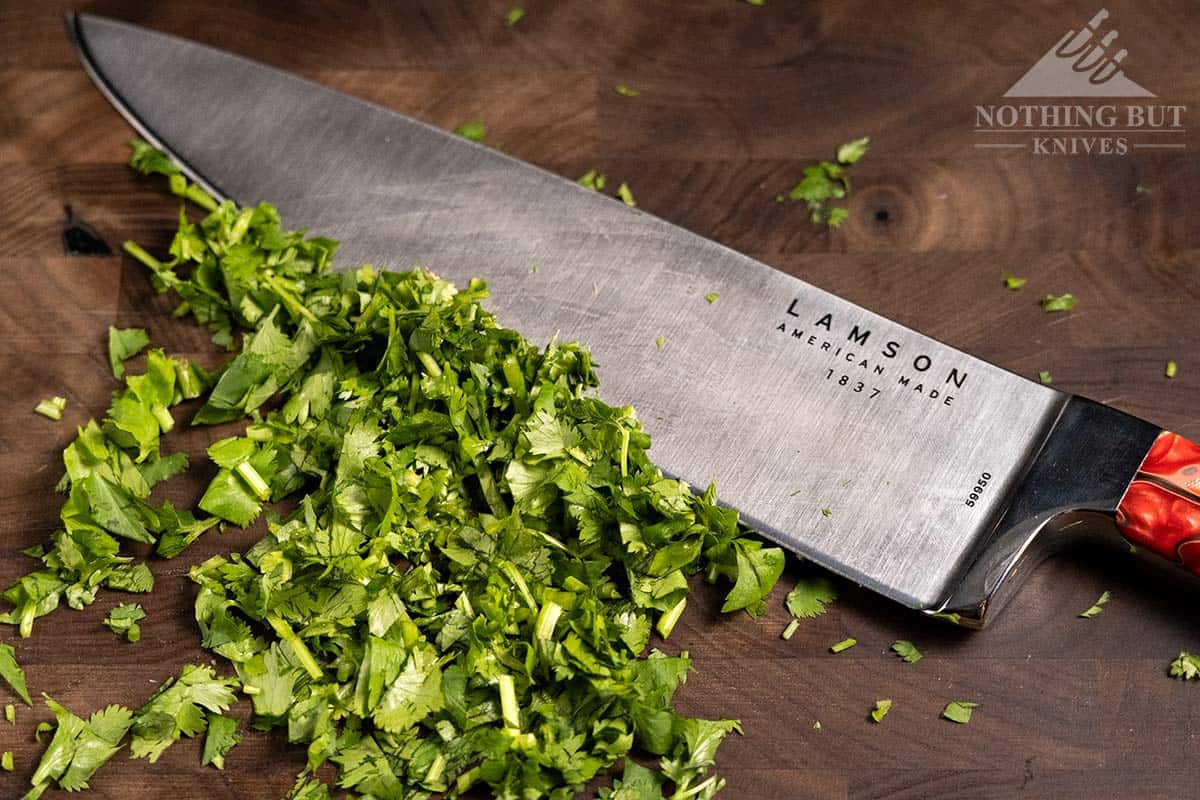
I like a lot of things about this knife. The weight, balance, and even the look weirdly line up to make something I enjoy using. My only complaints are that it could be a little sharper out of the box (even though it’s plenty sharp to be usable), and it has a full bolster.
If the edge really starts bothering me, the steel is easy enough to work with that I could thin it out if I wanted. Or I could just make use of Lamson’s lifetime sharpening warranty that they offer with all their knives.
The bolster is a more frustrating issue since Lamson doesn’t offer a half or integrated bolster version of their Premier chef knife. Past that, though, this is a good knife. It’s a good sign when all the knives I want to compare it to are more expensive, even if it doesn’t quite outperform those more expensive options.
I’d recommend this almost entirely on the quality of the company alone, but the solid craftsmanship on their knives helps too. It’s a great knife for a busy home cook, and I’d go so far as to say it’s worth a few professional cooks checking out as well.
